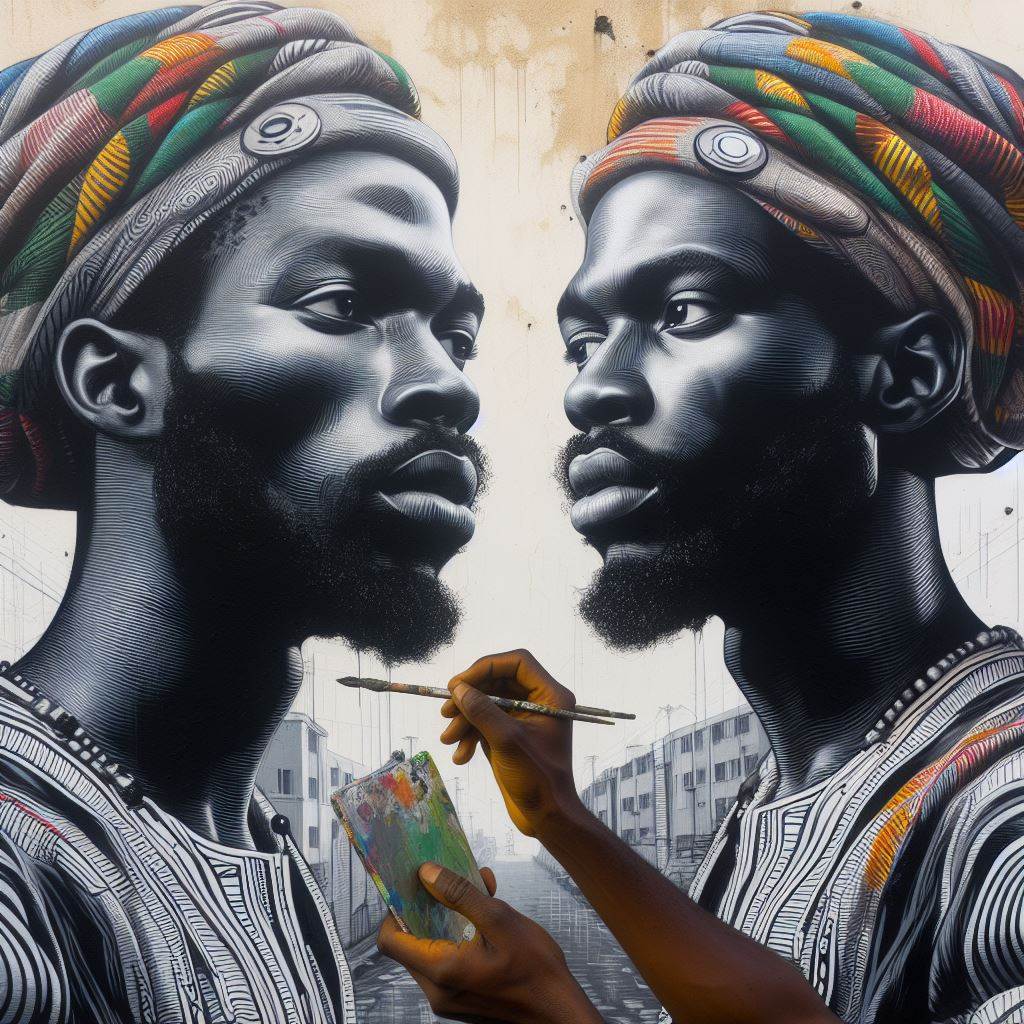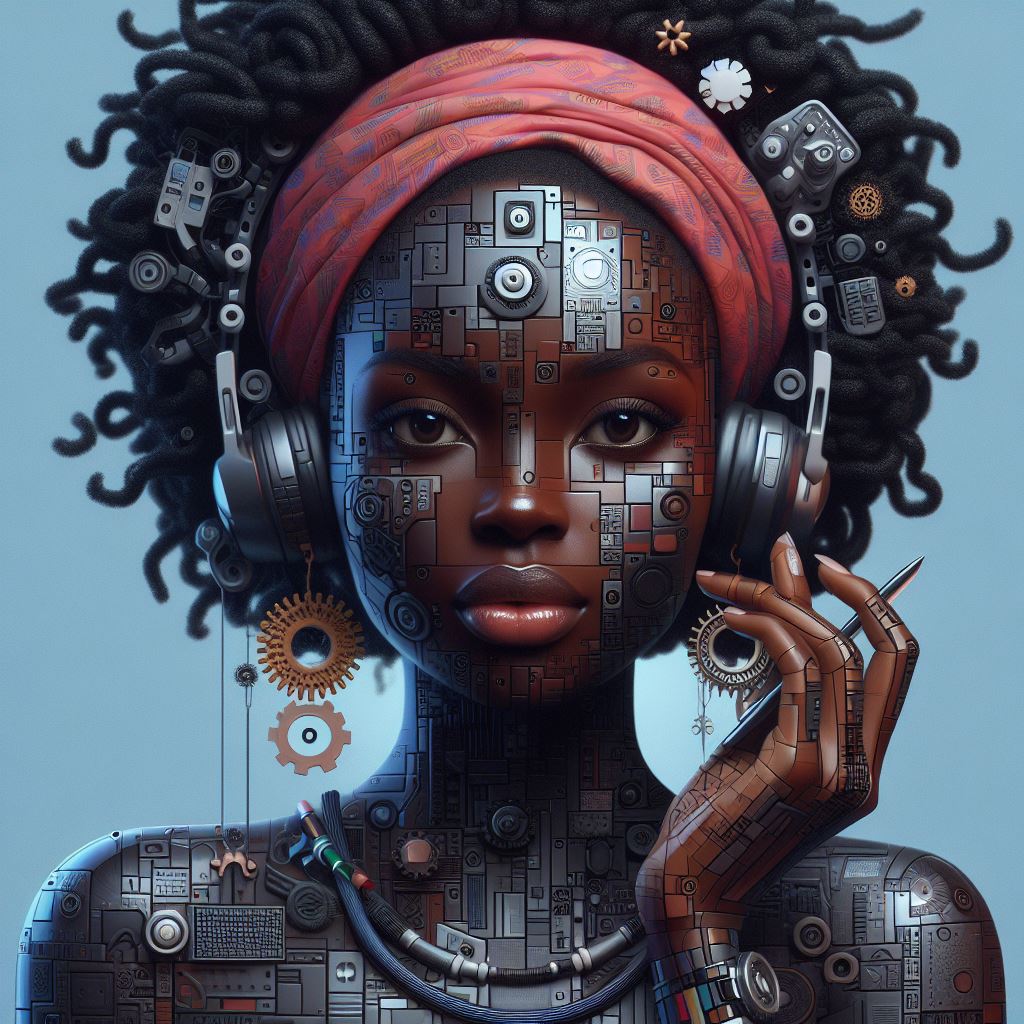Introduction
Embarking on a journey through Nigerian street art unveils a rich tapestry of cultural expression and creativity.
Tracing its origins from grassroots movements to mainstream prominence, Nigerian street art has evolved into a dynamic and vibrant art form.
At the heart of this artistic landscape lie murals, monumental artworks adorning the walls of cities across the country.
Murals, characterized by their grand scale and captivating imagery, serve as potent visual narratives, encapsulating the essence of Nigerian culture and identity.
From vibrant depictions of social issues to celebratory reflections of cultural heritage, these artworks offer a window into the soul of the nation.
Exploring Nigerian street art and murals is more than just admiring aesthetically pleasing visuals; it’s a profound journey into the heart of Nigerian society.
These artworks serve as catalysts for community engagement and social discourse, fostering connections and sparking conversations among diverse audiences.
Join us as we delve deep into the intricate world of Nigerian street art and murals, uncovering the stories, themes, and emotions that define this captivating art form.
Through this exploration, we aim to gain a deeper understanding of Nigerian culture and identity while celebrating the boundless creativity of its artists.
Overview of Nigerian street art scene
Nigerian street art has flourished over the years, becoming a vibrant expression of creativity and social commentary. Artists use public spaces to convey powerful messages and showcase their talents.
Street art in Nigeria is not just about aesthetics; it’s a form of communication and activism. The art form has gained popularity, drawing attention to the artists and the issues they highlight.
Mention of Popular Cities with Vibrant Street Art Scenes
Lagos is the heart of Nigeria’s street art scene, teeming with colorful murals and graffiti. The city’s walls tell stories of resilience, culture, and contemporary life.
Abuja, the nation’s capital, also boasts a growing street art community. Its murals often reflect political themes and national pride.
Port Harcourt and Ibadan are other cities where street art thrives, each with unique styles and local influences. These cities provide a dynamic canvas for artists to share their visions and messages.
Diversity of Styles and Themes in Nigerian Street Art
Nigerian street art is incredibly diverse, showcasing a wide range of styles and themes. Some artists use vibrant colors and bold lines to create eye-catching murals.
Others employ intricate designs and subtle color palettes to convey deeper meanings. Themes in Nigerian street art range from social justice and political activism to cultural heritage and environmental issues.
Artists draw inspiration from their surroundings, using their work to comment on daily life, struggles, and triumphs.
Influence of Local Culture, Politics, and History on Street Art
Local culture, politics, and history heavily influence Nigerian street art. Artists often incorporate traditional motifs and symbols into their work, paying homage to their heritage.
Political themes are prevalent, with murals addressing corruption, governance, and social inequality.
Historical events and figures also feature prominently, as artists seek to educate and inspire their communities.
For instance, murals commemorating the Nigerian independence movement can be seen in various cities, celebrating the nation’s history and achievements.
Nigerian street artists also respond to contemporary issues, such as the #EndSARS protests against police brutality.
Murals from this movement highlight the power of art as a tool for social change. By reflecting local and national concerns, street art in Nigeria serves as a mirror of society, capturing the zeitgeist of different eras.
Basically, the Nigerian street art scene is a vibrant and dynamic part of the country’s cultural landscape.
Cities like Lagos, Abuja, Port Harcourt, and Ibadan are hubs for this creative expression.
The diversity of styles and themes in Nigerian street art showcases the rich tapestry of the nation’s culture, politics, and history.
As artists continue to use public spaces to share their messages, Nigerian street art will undoubtedly grow in influence and impact.
Through their work, these artists bring color, conversation, and change to the streets of Nigeria, making art accessible to all.
Read: Exploring Semiotics in Communication Arts
Notable Nigerian street artists and muralists
When it comes to street art and murals in Nigeria, there are several talented artists making their mark on the scene. Here are some of the most prominent ones
Sola Olude
Sola Olude is a renowned Nigerian street artist known for his vibrant and colorful murals that often depict cultural and social themes. His work can be seen in cities across Nigeria, bringing life and color to urban spaces.
Rasheed Abayomi
Rasheed Abayomi is another well-known street artist who has gained recognition for his intricate and detailed murals. His work often explores themes of identity and history, offering a unique perspective on Nigerian culture.
Chiamaka Odukwe
Chiamaka Odukwe is a rising star in the Nigerian street art scene, known for her bold and expressive style. Her murals often feature powerful images and messages, making a strong impact on viewers.
Profiles of prominent artists and their contributions to the street art scene
Each of these artists has made significant contributions to the Nigerian street art scene, pushing boundaries and challenging the status quo. Let’s take a closer look at their profiles:
Sola Olude
Sola Olude’s work is characterized by its vibrant colors and intricate patterns, drawing inspiration from Nigerian culture and traditions. His murals can be found in public spaces, galleries, and museums, making a lasting impression on viewers.
Rasheed Abayomi
Rasheed Abayomi’s murals often explore themes of history and identity, reflecting the rich diversity of Nigerian culture. His attention to detail and skillful technique have earned him recognition both locally and internationally.
Chiamaka Odukwe
Chiamaka Odukwe’s work is known for its powerful imagery and strong messages, addressing social issues and advocating for change. Her murals have sparked important conversations and inspired others to use art as a form of activism.
Examples of their most famous works and collaborations
These artists have created some iconic pieces that have become landmarks in Nigerian cities. Here are a few examples of their most famous works and collaborations:
Sola Olude: “Unity in Diversity”
Sola Olude’s mural “Unity in Diversity” is a striking depiction of Nigeria’s cultural heritage, featuring colorful motifs and symbols that represent the country’s diverse ethnic groups. The mural has become a symbol of national unity and pride, drawing tourists and locals alike to admire its beauty.
Rasheed Abayomi: “Echoes of the Past”
Rasheed Abayomi’s mural “Echoes of the Past” is a powerful portrayal of Nigeria’s history, showcasing scenes from the country’s colonial past and struggle for independence.
The mural serves as a reminder of the sacrifices made by previous generations and the need to preserve Nigeria’s cultural heritage.
Chiamaka Odukwe: “Breaking Barriers”
Chiamaka Odukwe’s mural “Breaking Barriers” is a bold statement on social justice and equality, featuring images of diverse individuals coming together to dismantle systemic barriers.
The mural has inspired activism and solidarity, encouraging people to work towards a more inclusive society.
Impact of their art on the community and society
The art created by these Nigerian street artists has had a profound impact on the community and society at large. Here are some of the ways their work has made a difference:
Sola Olude
Sola Olude’s murals have transformed public spaces, turning drab walls into vibrant canvases that celebrate Nigerian culture. His art has brought communities together and instilled a sense of pride in local heritage.
Rasheed Abayomi
Rasheed Abayomi’s murals have sparked important conversations about Nigeria’s history and the need to preserve its cultural heritage. His work has inspired young artists to explore their roots and express themselves through art.
Chiamaka Odukwe
Chiamaka Odukwe’s murals have served as a platform for social activism, raising awareness about issues such as gender equality and human rights. Her art has inspired others to use their creativity to advocate for positive change in society.
Read: Cultural Exchange Between Nigeria and China
Challenges Faced by Nigerian Street Artists
Nigerian street artists encounter numerous challenges that impact their work and its sustainability. These artists often lack resources and funding for materials.
Additionally, they face societal misconceptions about the value and legitimacy of street art. Public perception frequently views their work as vandalism rather than valuable cultural expression.
This misunderstanding creates obstacles for artists seeking acceptance and appreciation for their creations.
Legal Issues Surrounding Street Art and Murals in Nigeria
Legal issues present significant challenges for Nigerian street artists. The lack of clear regulations regarding street art results in legal uncertainties.
Artists can face fines, arrest, or property damage claims for their work. Without explicit legal frameworks, artists struggle to navigate the boundaries of legality and artistic freedom.
Moreover, obtaining permits for murals is a complex and often bureaucratic process. This legal ambiguity stifles creativity and discourages artists from engaging in street art.
Lack of Recognition and Support from Government and Institutions
Government and institutional support for street art in Nigeria is minimal. This lack of recognition hampers the growth and development of the art form.
Public and private institutions rarely provide funding or platforms for street artists. The absence of official support limits opportunities for artists to showcase their work in prominent spaces.
Furthermore, without recognition, street art struggles to gain legitimacy as a respected cultural practice. This lack of support perpetuates the perception of street art as fringe or illegitimate.
Efforts to Preserve and Protect Street Art from Vandalism and Decay
Preserving and protecting street art from vandalism and decay is a critical concern. Street art is inherently vulnerable to environmental factors and intentional damage. Weather conditions can cause murals to fade and deteriorate quickly.
Vandalism, often driven by conflicting interests or sheer malice, further threatens these artworks. Efforts to preserve street art include community initiatives and collaborations with local businesses.
Protective coatings and regular maintenance help shield murals from the elements and damage.
Additionally, some artists and advocates work with authorities to create designated spaces for street art. These areas provide safer environments for artists to work and for the public to appreciate their art.
Therefore, Nigerian street artists face significant challenges, including legal issues, lack of recognition, and preservation difficulties.
Legal uncertainties and societal misconceptions hinder their ability to create freely and gain acceptance. Government and institutional support remain scarce, limiting opportunities for growth.
Despite these challenges, efforts to preserve and protect street art continue to emerge. Community initiatives and designated art spaces offer hope for the future of Nigerian street art.
As these efforts expand, they can help foster a more supportive environment for street artists. By addressing these challenges, Nigeria can nurture its vibrant street art culture and ensure its longevity.
Read: How to Open a Beauty Salon in Nigeria: Step-by-Step

Engagement with Nigerian street art and murals
Engaging with Nigerian street art and murals offers a unique way to experience the country’s vibrant culture.
Street art in Nigeria reflects the creativity and resilience of local artists, making it a vital part of urban life. Exploring these artworks allows individuals to connect with the artists’ stories and perspectives, enriching their understanding of Nigeria’s diverse society.
Ways to Experience and Appreciate Street Art in Nigeria
To fully appreciate Nigerian street art, start by exploring popular neighborhoods known for their murals. Cities like Lagos, Abuja, and Port Harcourt boast vibrant street art scenes.
Walking tours provide an immersive experience, allowing you to see the artwork up close. Many local guides offer street art tours, sharing insights about the artists and their inspirations.
Additionally, social media platforms like Instagram showcase the latest works and locations. Follow Nigerian street artists and street art pages to stay updated on new pieces and exhibitions.
Importance of Community Involvement in Supporting Local Artists
Community involvement plays a crucial role in supporting Nigerian street artists. Local businesses can sponsor murals, providing both financial support and visibility for the artists.
Schools and community centers can collaborate with artists to create educational murals, fostering an appreciation for art among young people.
Residents can engage by attending street art events and workshops. These activities not only support the artists financially but also build a sense of community pride and ownership of public art.
Opportunities for Tourists and Art Enthusiasts to Engage with Nigerian Street Art
Tourists and art enthusiasts have numerous opportunities to engage with Nigerian street art. Participating in guided street art tours offers a comprehensive understanding of the art and its cultural significance.
These tours often include visits to hidden gems and famous murals, providing a well-rounded experience.
Art festivals, such as the Lagos Street Art Festival, showcase the best of Nigerian street art and offer interactive experiences.
Tourists can also visit galleries that feature street art-inspired works, bridging the gap between street and gallery art.
Additionally, many street artists sell prints and merchandise, allowing enthusiasts to take a piece of the art home while supporting the artists.
In review, engaging with Nigerian street art and murals enriches one’s understanding of the country’s culture and creativity.
Experiencing this art form through walking tours, social media, and local events offers a deeper connection to the vibrant urban landscape.
Community involvement is essential for supporting local artists, fostering a sense of pride and ownership.
Tourists and art enthusiasts can engage with Nigerian street art through guided tours, festivals, and gallery visits, enhancing their appreciation for this dynamic art form.
By supporting and engaging with Nigerian street art, we contribute to the growth and recognition of these talented artists, ensuring the sustainability of this cultural expression.
Overall, Nigerian street art and murals offer a unique and colorful glimpse into the country’s rich cultural heritage and artistic creativity. By actively engaging with and supporting local artists, you can contribute to the preservation and appreciation of this dynamic art form.
Read: Cosmetology and Beauty Therapy Scholarships in Nigeria
Explore Further: Exam Tips for International Politics Students Nigeria
Explore Further: Online Courses for English Language Students in Nigeria
Transform Your Career with Expert Guidance
Get personalized mentorship consulting that’s tailored to your unique path. Our expert advice is actionable and exclusive.
Get StartedLearn More: Exploring Nigerian Art Through Photography
Explore Further: Islamic Law Studies in Nigerian Universities
Impact of Nigerian street art on society
Nigerian street art has a profound impact on society, shaping public spaces and influencing social discourse.
Street art in Nigeria goes beyond aesthetics; it serves as a powerful medium for communication and expression. Artists use murals to address societal issues, making art accessible to everyone.
These public artworks foster community pride and encourage dialogue among diverse groups.
Role of Street Art in Promoting Social Change and Activism
Street art in Nigeria plays a crucial role in promoting social change and activism. Artists use their work to highlight pressing issues such as corruption, inequality, and environmental degradation.
Murals serve as visual protests, capturing public attention and inspiring collective action. For instance, murals advocating for women’s rights or environmental conservation spark conversations and mobilize communities towards change.
By addressing these issues publicly, street art amplifies the voices of marginalized groups and encourages societal transformation.
Influence of Street Art on Urban Development and Revitalization
Street art significantly influences urban development and revitalization in Nigerian cities. Murals transform neglected areas into vibrant, attractive spaces, encouraging tourism and economic activity.
In cities like Lagos and Abuja, street art has revitalized neighborhoods, attracting businesses and improving the quality of life.
Local governments and private developers recognize the value of street art in urban renewal, often commissioning artists to create murals that enhance public spaces.
These artworks not only beautify the environment but also instill a sense of community pride and ownership.
Reflection of Nigerian Identity and Cultural Values in Street Art
Nigerian street art reflects the country’s rich cultural heritage and diverse identity. Artists incorporate traditional symbols, patterns, and themes into their murals, celebrating Nigeria’s history and cultural values.
For instance, murals featuring Yoruba, Igbo, and Hausa motifs showcase the country’s ethnic diversity.
These artworks serve as visual narratives, preserving cultural stories and educating younger generations. Street art becomes a medium through which cultural pride is expressed and shared with the world.
Nigerian street art has a transformative impact on society, promoting social change, influencing urban development, and reflecting cultural identity.
Artists use their murals to address societal issues, fostering dialogue and inspiring action. Street art revitalizes urban areas, attracting tourism and economic activity while enhancing community pride.
Moreover, it serves as a powerful expression of Nigerian cultural values, celebrating the country’s diverse heritage.
As street art continues to evolve, its role in shaping Nigerian society and preserving cultural identity becomes increasingly significant.
By supporting and engaging with Nigerian street art, individuals contribute to the sustainability and growth of this dynamic art form, ensuring its continued impact on society.
Through street art, Nigeria’s vibrant culture and resilience are vividly portrayed, enriching both the local and global art landscapes.
Conclusion
In concluding our journey through the colorful landscapes of Nigerian street art and murals, it becomes abundantly clear that these expressive forms are not merely decorative embellishments but profound reflections of the nation’s soul.
From the bustling streets of Lagos to the quieter corners of Kano, these artworks serve as vibrant testaments to Nigeria’s rich cultural tapestry and diverse identity.
As we immerse ourselves in the intricate details and bold strokes of these murals, we uncover stories of resilience, creativity, and social commentary woven into their very fabric.
Yet, our exploration does not end here; rather, it marks the beginning of a collective endeavor to support and uplift the local street artists who breathe life into these urban canvases.
Therefore, let us heed the call to action and become advocates for the arts, championing the cause of Nigerian street artists and ensuring their invaluable contributions receive the recognition they deserve.
Let us continue to traverse the streets with open eyes and open hearts, discovering the hidden gems and powerful narratives etched onto the walls of our cities.
For in celebrating the beauty of Nigerian street art, we celebrate the essence of our shared humanity and the boundless creativity that unites us all.




